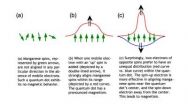(Press-News.org) HOUSTON - Current and former heavy smokers can now be screened more effectively for lung cancer. Results from the National Lung Screening Trial (NLST) revealed that detecting small lung cancers with computed tomography (CT) reduces lung cancer specific mortality by 20 percent.
Prior to the trial, lung cancer, often diagnosed in the later stages of the disease, had shown no benefit from screening because screening with standard chest X-rays did not detect cancers early enough. The trial, funded by the National Cancer Institute (NCI), is the driving force behind a new program offered at The University of Texas MD Anderson Cancer Center.
MD Anderson's Lung Cancer Screening Program teams experts in thoracic surgery, radiology, pulmonary and clinical cancer prevention who have developed a step-by-step program to better detect, treat and educate high-risk individuals against lung cancer.
"Our program is unique because we do more than a comprehensive lung CT screening exam," said Therese Bevers, M.D., medical director of MD Anderson's Cancer Prevention Center. "We offer preventive options to help reduce their risk for cancer. Based on the findings from the screening lung CT, we guide people through the diagnostic evaluation and, if needed, treatment."
MD Anderson is offering screening to current or former smokers 50 years of age or older who have smoked the equivalent of one pack of cigarettes a day for at least 20 years. In addition to screening, the program offers access to other services through the Cancer Prevention Center, including risk assessment counseling for those found to not have lung cancer and low-cost tobacco cessation programs to help smokers quit.
MD Anderson's program is based on initial findings reported last fall from the NLST. The findings, scheduled to be published in the June 29 New England Journal of Medicine, revealed a 20 percent reduction in lung cancer deaths for participants who received the low-dose helical CT scan compared with those undergoing a standard chest X-ray.
Clinical Trial Results Add Weight
MD Anderson was one of 33 sites involved in the national trial and one of 10 sites that collected biomarkers to use in NLST secondary trials. More than 780 MD Anderson participants were enrolled in the trial. The trial randomized 53,000 current or former smokers - ages 55 to 74 - into two screening groups to compare and examine lung cancer mortality.
"This is a major finding for lung cancer patients and health care policy in the United States," said Reginald Munden, M.D., a professor in Department of Diagnostic Radiology and lead investigator at MD Anderson on the trial. "The goal of our lung cancer screening program is to improve the health of lung cancer patients."
Munden hopes the trial results will pique the interest of current smokers to join a smoking-cessation program. Because many former smokers are at a high risk for developing lung cancer, MD Anderson hopes to draw that population to the screening program as well. "We had a tremendous amount of interest in the trial when it first opened, and we anticipate there will be more people asking to be screened with the release of the trial findings," said Munden.
The Costs of Saving Lives
As promising as the findings are, not all smokers and former smokers are recommended for lung cancer screening. There are certain risks associated with screening, including radiation exposure and false positives that may require additional testing and discomfort.
"Now that we have scientific proof that screening a specific high-risk group can reduce mortality in lung cancer patients, the benefits of the screening outweigh the risks for those people," said Bevers, who was MD Anderson co-investigator on the national trial.
Cost can be a barrier to screening, because insurance companies do not cover the expense of lung cancer screening. Previous studies did not prove a benefit to X-ray screening. With the challenging economy and rising costs of medical care, the out-of pocket expense may deter some from getting screened, and the screening results could lead to further tests that may involve additional costs.
MD Anderson is charging $400 for a lung cancer screening, but experts consider this worth it if it will reduce the number of lung cancer deaths. "There are more costs associated with treating lung cancer," said Munden.
The trial also includes a cost-effective analysis. Researchers are comparing the cost of lung cancer care to the cost of covering lung cancer screening. "If the analysis demonstrates a reduction in the cost of lung cancer care, then the adaptation will be rapid," said Munden.
Results from the cost analysis are expected to be released later this year.
###
For more information about lung cancer screening, please visit the Cancer Prevention Center website.
To schedule an appointment, please contact askMDAnderson at 1-877-MDA-6789.
About MD Anderson
The University of Texas MD Anderson Cancer Center in Houston ranks as one of the world's most respected centers focused on cancer patient care, research, education and prevention. MD Anderson is one of only 40 comprehensive cancer centers designated by the National Cancer Institute. For seven of the past nine years, including 2010, MD Anderson has ranked No. 1 in cancer care in "America's Best Hospitals," a survey published annually in U.S. News & World Report.
UT MD Anderson debuts lung cancer screening program
Experts mobilize after national clinical trial shows CT scanning reduces deaths by 20 percent
2011-06-30
ELSE PRESS RELEASES FROM THIS DATE:
Money and mimicry
2011-06-30
"Money, money, money
Must be funny
Money, money, money
Always sunny
In the rich man's world."
-ABBA, 1976
We rely on money in our day-to-day life and it is constantly in our minds. After all, money makes the world go round, doesn't it? Now, a new study, which will be published in an upcoming issue of Psychological Science, a journal of the Association for Psychological Science, tries to better understand the psychological effect of money and how it affects our behavior, feelings and emotions.
Jia Liu, at the University of Groningen, co-wrote the article along with ...
The Push for Honorable Discharge Status for Those Expelled Under "Don't Ask, Don't Tell"
2011-06-30
For years, homosexuality was grounds for discharge from the armed services of the United States. In 1993, President Clinton initiated the controversial "don't ask, don't tell" ("DADT") policy as a compromise that required gay soldiers to be discreet about their sexuality or face being thrown out of the military. DADT ruled the military policy on homosexuality for 17 years.
But, on December 22, President Obama signed into law a bill that will allow gay men and women to serve openly in uniform for the first time in U.S. History. After certification ...
At small scales, tug-of-war between electrons can lead to magnetism
2011-06-30
BUFFALO, N.Y. -- At the smallest scales, magnetism may not work quite the way scientists expected, according to a recent paper in Physical Review Letters by Rafał Oszwałdowski and Igor Žutić of the University at Buffalo and Andre Petukhov of the South Dakota School of Mines and Technology.
The three physicists have proposed that it would be possible to create a quantum dot -- a kind of nanoparticle -- that is magnetic under surprising circumstances.
Magnetism is determined by a property all electrons possess: spin. Individual spins are akin to tiny bar ...
Four Attorneys from Albany-Area Law Firm Selected for New York Super Lawyers List
2011-06-30
Four attorneys from Hacker Murphy, LLP, in Latham, NY, have been selected for inclusion in 2011 New York Super Lawyers. The four attorneys are James E. Hacker, David R. Murphy, John F. Harwick and Mark R. Sonders.
The Super Lawyers selections are based on an annual process in given jurisdictions. Only five percent of the lawyers in each jurisdiction are typically selected.
Three of the four Hacker Murphy attorneys selected this year for the New York Super Lawyers list have been selected before. James E. Hacker was selected from 2006 to 2009. David R. Murphy and Mark ...
Immigration Law Review Article Written by Houston Attorney Benny Agosto Jr. Has Appeared In Several Publications
2011-06-30
Houston personal injury attorney Benny Agosto Jr. of Abraham, Watkins, Nichols, Sorrels, Agosto & Friend is receiving nationwide recognition once again.
While attorney Benny Agosto is often recognized for his dedication to the Houston community and the legal profession, this time he is being singled out for his work on the widely published immigration article "But Your Honor, He's an Illegal! Can the Undocumented Worker's Alien Status Be Introduced at Trial?"
Co-authored with Texas Southern University Law Prof. Lupe Salinas and Texas attorney Eloisa ...
New therapy for childhood neuroblastoma proves feasible and safe
2011-06-30
Reston, Va. (June 29, 2011) – A new treatment option may soon be available for children with neuroblastoma according to research published in the July issue of The Journal of Nuclear Medicine. The study tested the principle that combined positron emission tomography and X-ray computed tomography (PET/CT) may be used to select children with primary refractory or relapsed high-risk neuroblastoma for treatment with a molecular radiotherapy known as 177Lu-DOTATATE. This therapeutic option was found to be viable option for children with neuroblastomas.
Neuroblastoma is a ...
Shortening time between CPR and shocks improves cardiac-arrest survival
2011-06-30
DALLAS – June 29, 2011 – Reducing the intervals between giving cardiopulmonary resuscitation (CPR) and an electronic defibrillator shock after cardiac arrest significantly improves survival, according to UT Southwestern Medical Center emergency medicine doctors involved in an international study.
Chest compressions applied within 10 seconds before the defibrillator shocks and within 20 seconds after the shock boosted survival chances by more than half compared to the rates for people who received chest compressions more than 20 seconds before or 40 seconds after the shock, ...
UBC researchers invent new drug delivery device to treat diabetes-related vision loss
2011-06-30
A team of engineers and scientists at the University of British Columbia has developed a device that can be implanted behind the eye for controlled and on-demand release of drugs to treat retinal damage caused by diabetes.
Diabetic retinopathy is the leading cause of vision loss among patients with diabetes. The disease is caused by the unwanted growth of capillary cells in the retina, which in its advanced stages can result in blindness.
The novel drug delivery mechanism is detailed in the current issue of Lab on a Chip, a multidisciplinary journal on innovative microfluidic ...
Columbia SC Hotel Offers Convenient Lodging to Students Attending Freshman Orientation at the University of South Carolina
2011-06-30
The newly opened Hilton Garden Inn Hotel in Columbia SC (Northeast) offers convenient lodging to students and their parents who will be attending freshman orientation at the University of South Carolina. There are just a few days left for students to pre-register to attend an orientation session. The one day sessions are held weekdays through July 7. Orientation will provide students with key information that will help them make a successful transition into the university. Students will be able to meet with academic advisors, register for fall classes, visit residence halls, ...
Global warming could alter the US premium wine industry in 30 years, says Stanford study
2011-06-30
Higher temperatures could significantly impact California and other premium winegrowing regions of the United States in the next 30 years, according to a new study led by Stanford University climate scientists.
Writing in the June 30 edition of Environmental Research Letters, the scientists
report that by 2040, the amount of land suitable for cultivating premium wine grapes in high-value areas of northern California could shrink by 50 percent because of global warming. However, some cooler parts of Oregon and Washington State could see an increase in premium grape-growing ...
LAST 30 PRESS RELEASES:
Making lighter work of calculating fluid and heat flow
Normalizing blood sugar can halve heart attack risk
Lowering blood sugar cuts heart attack risk in people with prediabetes
Study links genetic variants to risk of blinding eye disease in premature infants
Non-opioid ‘pain sponge’ therapy halts cartilage degeneration and relieves chronic pain
AI can pick up cultural values by mimicking how kids learn
China’s ecological redlines offer fast track to 30 x 30 global conservation goal
Invisible indoor threats: emerging household contaminants and their growing risks to human health
Adding antibody treatment to chemo boosts outcomes for children with rare cancer
Germline pathogenic variants among women without a history of breast cancer
Tanning beds triple melanoma risk, potentially causing broad DNA damage
Unique bond identified as key to viral infection speed
Indoor tanning makes youthful skin much older on a genetic level
Mouse model sheds new light on the causes and potential solutions to human GI problems linked to muscular dystrophy
The Journal of Nuclear Medicine ahead-of-print tip sheet: December 12, 2025
Smarter tools for peering into the microscopic world
Applications open for funding to conduct research in the Kinsey Institute archives
Global measure underestimates the severity of food insecurity
Child survivors of critical illness are missing out on timely follow up care
Risk-based vs annual breast cancer screening / the WISDOM randomized clinical trial
University of Toronto launches Electric Vehicle Innovation Ontario to accelerate advanced EV technologies and build Canada’s innovation advantage
Early relapse predicts poor outcomes in aggressive blood cancer
American College of Lifestyle Medicine applauds two CMS models aligned with lifestyle medicine practice and reimbursement
Clinical trial finds cannabis use not a barrier to quitting nicotine vaping
Supplemental nutrition assistance program policies and food insecurity
Switching immune cells to “night mode” could limit damage after a heart attack, study suggests
URI-based Global RIghts Project report spotlights continued troubling trends in worldwide inhumane treatment
Neutrophils are less aggressive at night, explaining why nighttime heart attacks cause less damage than daytime events
Menopausal hormone therapy may not pose breast cancer risk for women with BRCA mutations
Mobile health tool may improve quality of life for adolescent and young adult breast cancer survivors
[Press-News.org] UT MD Anderson debuts lung cancer screening programExperts mobilize after national clinical trial shows CT scanning reduces deaths by 20 percent



